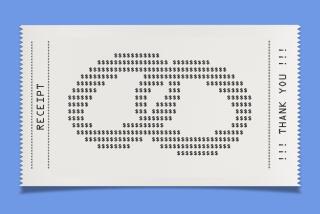They’ve Achieved Success Teaching That Big Bucks May Mean Little Life
- Share via
SEATTLE — In a money-hungry world forever chanting “More!,” Vicki Robin and Joe Dominguez find simple pleasure in saying “Enough.”
Each lives on a yearly budget of about $6,000, well below the federal poverty level. And although that’s not unusual these days, Robin and Dominguez stand out for three reasons:
* They live as they do by choice.
* They wrote a book urging everyone to do the same.
* People actually are buying it.
The authors have become gurus of the New Frugality, offering a morning-after remedy of thrift for the 1980s bacchanal of consumerism. Their book, “Your Money or Your Life,” is among a shelf full of popular new business and personal-finance offerings emphasizing spiritual as well as material gains.
Grabbing all you can is out; making do with what you have is in. Instant gratification is out; long-term gains are in. Conspicuous is out; conscious is in.
At the heart of it all is a concept that may seem revolutionary to a credit-card generation of baby boomers but was obvious to their grandparents: Live within your means.
“This is not a fad,” Dominguez said. “It’s a philosophy upon which this country was founded. It’s about squeezing the buck until the eagle grins. This is where we come from. We forgot.”
There are plenty of new books and newsletters to help us remember:
* “Your Money or Your Life,” published by Viking in September, is in its sixth printing with more than 100,000 copies distributed. It has made the New York Times’ bestseller list of how-to books four times.
* The Tightwad Gazette, by Amy Dacyczyn, a housewife in Leeds, Me., is full of homespun hints for pinching pennies: Buy peanut butter by the case, make your own pizza instead of ordering out. Published by Villard, the book compiles the first two years of Dacyczyn’s monthly newsletter, which has grown from 1,700 subscribers to 80,000 since 1990.
* The Living Cheap News, published in San Jose, Calif., was started a year ago by Larry Roth, who found The Tightwad Gazette too countrified. His monthly newsletter offers money-saving tips for city slickers.
Some advice treads the line between frugal and downright miserly. Roth, for example, says he uses the same coffee grounds for days but concedes that might not be to everyone’s taste.
The goal, he and the others say, is conscious spending, not deprivation.
“I’m not into hair shirts and torn Levi’s,” Dominguez said. “I’m into: ‘Cool it, the mall is not the new temple.’ Slow it down. Most middle-class folks are not going to suffer if they are salting away 10% to 20% of their income instead of spending it at the mall.”
Dominguez and Robin suggest that instead of measuring purchases strictly by the dollar, people should consider how much time, or “life energy,” they lose on the earn and spend treadmill.
In “Your Money,” they offer a sobering calculation of how a seemingly high-paying job can yield surprisingly little per hour--once the costs of commuting, parking, meals and nice clothes are deducted and then divided by hours working, traveling and recovering from job-induced stress and illness.
Dominguez and Robin jumped off their own treadmills more than 20 years ago.
Dominguez, 54, worked as a Wall Street analyst. But after his company folded, he resolved at the age of 25 never to be dependent on an employer again. He got another job, started saving, and within five years had socked away $80,000. He quit his job and has been living off the interest ever since.
Robin, 47, grew up in a well-off family on Long Island. Graduating from Brown, she pursued acting in New York but grew disillusioned and hit the road with a $20,000 inheritance. She met Dominguez while traveling in Mexico.
They live in Seattle, sharing a 3,600-square-foot house with three others. They paid off the mortgage three years ago, and Dominguez and Robin are masters at keeping other costs to bare bones.
A shopping spree for Robin is buying a used jumpsuit at a thrift shop. Dominguez does his errands, rain or shine, by bicycle. Rather than go to restaurants, they’ll invite friends over for a potluck dinner.
Their simple lifestyle was supposed to be a means to an end. Dominguez and Robin said it gave them more time for volunteer work and meshed with their goal of moving society toward more sustainable, less environmentally destructive ways.
But friends wondered how they made ends meet, so Dominguez started giving living-room talks on his financial strategy in 1980.
By 1985, he was traveling the country, giving seminars in packed auditoriums. When it started seeming too much like work, Dominguez produced an audiocassette course in 1986, selling them through direct mail. More than 30,000 sets have sold, with all proceeds going to the New Road Map Foundation, a nonprofit volunteer group Dominguez and Robin founded.
Interest in frugality spread slowly in the 1980s, then mushroomed in 1990, Robin said.
“It’s almost as if we turned the decade, and the morning after, people knew we were going to have to do something different,” she said. “They knew the free flow of money of the ‘80s was over--that the faucet was shutting down.”
More recently, recessionary fears have kept interest high, but deeper motivations will make frugality a defining social trend of the 1990s, Robin said.
For some aging baby boomers, it’s a matter of valuing time more than money and family more than career. They made the big bucks and spent them, only to find that possessions didn’t make them happy.
Others never achieved the Madison Avenue ideal of consumerism, and they are losing hope that they ever will. Frugality is a useful philosophical underpinning for reduced expectations.
For still others, it’s a simple case of maturity. Young people, flush with the newfound power of a paycheck, often feel they have their entire lives to make up for the money they’re about to merrily squander. But after age 30, visions of mortality (and meager retirement benefits) start to gnaw.
Consider Mike and Linda Lenich of the Chicago suburb of South Holland. They followed the nine-step program in “Your Money or Your Life” and now save money with the fervor of religious converts.
Not that they have to. Mike, 38, is a quality control coordinator for Commonwealth Edison, and Linda, 35, teaches quilting at a community college. Together, they gross $60,000 a year.
But they know security can vanish overnight. Growing up near South Side steel mills, they saw well-paid millworkers lose their jobs and have nothing to show for years of work.
The Leniches never considered themselves wild spenders, but once they probed their finances, they found plenty of holes where the money leaked through.
Mike, an avid reader, goes to the library instead of buying books. Linda puts a jug of iced tea in the car so she won’t be tempted to stop at a fast-food place for soda. They buy groceries in bulk, twice a month.
Instead of “moving up” from their 1,400-square-foot home, as friends suggested, they changed their 30-year mortgage to a 15-year loan and started making two extra principal payments a month. They plan to pay off the mortgage by 1997.
“Our home is extremely comfortable,” Mike said. “It would be nice to have bigger rooms. But to spend $200,000 or $300,000 for that? It’s not worth it.”
In December, while watching television, the Leniches realized they had immunized themselves against creeping materialism.
Buy a fur coat for Christmas, a TV commercial urged: “Now that you’ve made it to the end of the year, you deserve it.”
In holidays past, they might well have bought it--the sentiment, at least, if not the coat. But this time, all they could do was laugh.
“We deserve it?” Linda exclaimed. “Come on! The things you buy won’t bring you happiness. If you’re always buying and spending and getting, it drives you crazy.”
More to Read
Sign up for our Book Club newsletter
Get the latest news, events and more from the Los Angeles Times Book Club, and help us get L.A. reading and talking.
You may occasionally receive promotional content from the Los Angeles Times.









